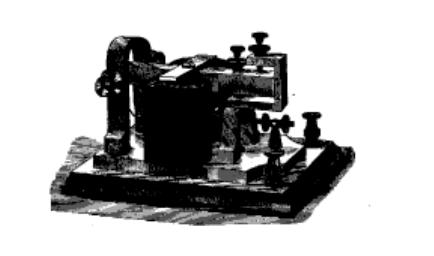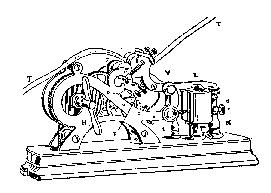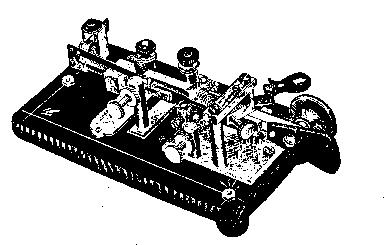
Copyright © 1997, Neal McEwen
Question: "In your last article, you referred to the telegraph systems as the "Electromagnetic Telegraph." Why? We all know the Telegraph was Electric.
Answer: Before the telegraph as we know it and as discussed in this column, there was a mature signaling system based on communicating with semaphores. These were actually large mechanical semaphores located in towers especially constructed for the purpose of semaphore signaling. They were located on a high spot on the terrain, usually about fifteen miles apart. An operator would send a message by manipulating the controls of the semaphore. The operator on the next hill over would copy the message and semaphore relay it to the next operator on the next hill. And so on and so forth. This proved especially valuable along the coasts to announce to business men and harbor masters, the arrival of a ship. The Semaphore system predates the Morse system by 100 years. This system of signaling was called "The Telegraph." Place name artifacts from this period remain today; many "Telegraph Hill" place names have survived. The term Electromagnetic Telegraph or Electric Telegraph was used in the mid 19th century and beyond to distinguish between the semaphore telegraph system and the wire telegraph system.
Telegraph instruments can be classified into three categories, landline instruments, wireless / radiotelegraph instruments and submarine cable instruments. Let's take a look at each of them.
Landline instruments, of course, date back to the origins of the
Electromagnetic Telegraph. You are probably familiar with the telegraphkey. The
key (typical key shown above) was used by the operator to send the Morse code.
The basic key consists of a lever, operated in an up and down motion, to
complete the telegraph circuit, sending dots and dashes down the wire. The key
evolved from a simple utilitarian device as used by Morse and Vail in the
1840s, shown in the column heading above, to a highly refined instrument
capable of comfortable, high speed sending by the mid 1880s. Landline keys were
used commercially through the  1960s; there were
many brands and variations. (The key is generally accepted as Morse's partner
Alfred Vail's contribution)
1960s; there were
many brands and variations. (The key is generally accepted as Morse's partner
Alfred Vail's contribution)
A receiving operator listened to the dots and dashes on a telegraph sounder. The is basically an electromagnet with an armature that moves in concert with the current in the wire. As the armature moves back and forth, the it makes a clicking noise, once for the make of the key and once for the break of the key. A dot is distinguished from a dash by the duration between clicks. Sounder design did not change a lot over the years. As with keys, they were used commercially through the 1960s. As with key, there were many brands, but not as many variations.
Telegraph lines were copper or iron wire. Hence after a certain
distance, the resistance of the wire attenuated the current in the line,
rendering the sounder insensitive. To extend the useful range of the telegraph,
relays were used. The relay is basically an electromagnet as is the
sounder. However, the solenoids of the electromagnet usually have more
turns of wire and therefore are quite sensitive. The armature, instead of
making a clicking noise, was one half of a set of contacts. When the operator
on the sending end pressed his key, the armature completed a new circuit. The
relay is the mid 19th century electromechanical version of the 20th century
amplifier. Relays had the same life cycle as keys and sounders. However, they
are not as plentiful as keys and sounders because not every installation
required one. (The relay was the genius of Joseph Henry, two decades before
Morse put it to practical use.)
However, the solenoids of the electromagnet usually have more
turns of wire and therefore are quite sensitive. The armature, instead of
making a clicking noise, was one half of a set of contacts. When the operator
on the sending end pressed his key, the armature completed a new circuit. The
relay is the mid 19th century electromechanical version of the 20th century
amplifier. Relays had the same life cycle as keys and sounders. However, they
are not as plentiful as keys and sounders because not every installation
required one. (The relay was the genius of Joseph Henry, two decades before
Morse put it to practical use.)
In the very early days of telegraphy, the receiving operator did not
copy the code on a sounder. The operator used a "Morse register." The register
was similar to a sounder, except that the armature did not make a clicking
noise. The armature was connected to a stylus. The stylus responded to the
moving armature by scribing dots and dashes onto a paper tape. The paper tape
was moved through the register by a clockwork and weight system. The stylus was
used in favor of a pen or pencil arrangement for ease of maintenance. The
register recorded, or registered, the incoming message; hence the name
register. Registers are fairly uncommon. As the sounder took over the receiving
chores, the need for registers diminished. However, they continued to be used
in applications where a permanent record was required and in fire alarm systems
well into the 20 century. (The register was one of Morse's original
contributions)
connected to a stylus. The stylus responded to the
moving armature by scribing dots and dashes onto a paper tape. The paper tape
was moved through the register by a clockwork and weight system. The stylus was
used in favor of a pen or pencil arrangement for ease of maintenance. The
register recorded, or registered, the incoming message; hence the name
register. Registers are fairly uncommon. As the sounder took over the receiving
chores, the need for registers diminished. However, they continued to be used
in applications where a permanent record was required and in fire alarm systems
well into the 20 century. (The register was one of Morse's original
contributions)
Telegraphers, making the up and down motion on their keys all day,
were often the victim of an occupational hazard related to the muscles of the
wrist and forearm. Today we call this malady "carpal tunnel syndrome." In the
19th century it was called "telegrapher's paralysis" or "glass arm." To
alleviate some of the stress, the "semi-automatic" key was invented at the turn
of the century. Today we are more familiar with the name "bug" to
describe the semi-automatic key. The "bug" has a lever such that when pushed to
one side, the operator can make a dash similar in manner to making a dash on
the older style key. When the lever is pushed in the opposite direction, the
"bug" makes dots in rapid succession until the operator releases the lever.
This action, besides being in the horizontal plane rather than the vertical
plan, has reduced significantly, the required manipulation to form the
characters of the code. "Bugs" are very plentiful. Besides being in landline
service, they were also in wireless / radiotelegraph service and are still
manufactured today for amateur radio ("ham") operators. It is estimated that
several hundred thousand bugs have been made by sixty plus manufactures from
the turn of the century through the 1960s. (The "bug" was invented by Horace
Martin)
the name "bug" to
describe the semi-automatic key. The "bug" has a lever such that when pushed to
one side, the operator can make a dash similar in manner to making a dash on
the older style key. When the lever is pushed in the opposite direction, the
"bug" makes dots in rapid succession until the operator releases the lever.
This action, besides being in the horizontal plane rather than the vertical
plan, has reduced significantly, the required manipulation to form the
characters of the code. "Bugs" are very plentiful. Besides being in landline
service, they were also in wireless / radiotelegraph service and are still
manufactured today for amateur radio ("ham") operators. It is estimated that
several hundred thousand bugs have been made by sixty plus manufactures from
the turn of the century through the 1960s. (The "bug" was invented by Horace
Martin)
Whoops, I've run out of room. I told the editors that I would keep the column to about 1,000 words or so. We will continue our discussion telegraph instrument types next month. In the meantime, I'd be happy to hear from you.
Back to NJARC website articles index